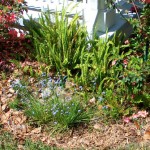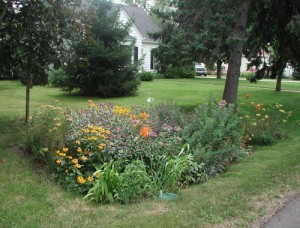Rain Garden Basics
What is a rain garden? Rain gardens are ways to control run-off, to filter water that may be polluted with chemical or trash, to keep water away from your house and to recharge the ground water. Rain gardens are not water gardens (there should never be standing water for more than a few hours), they do not require special plants (careful selection of common garden plants does the job) and they do not stand out in a landscape. Once planted and growing they are just another part of your home’s planting scheme.
What makes a rain garden? A rain garden is created by directing water from a roof, driveway or other hard surface to an area that has been designed to absorb water quickly and efficiently. The water is moved underground through pipes or over the surface via well established turf or rock-lined channels. An area of soil has been removed and replaced with a mixture of native soil and compost which will allow excess water to move quicklythrough the bed. The plantings– perennials, shrubs and trees– all help take up water and to filter it before the remainder percolates down to recharge groundwater.
Why should you want a rain garden? Because runoff from your roof or driveway is both a potential problem and wasted water. As it seeks lower ground, it may flood your basement or lawn, cut gullies in your yard and damage your plantings. It may carry pollutants to nearby streams or ponds. Controlled, it benefits your yard and the environment.
Where would you put a rain garden? It’s going to depend on your yard. You will want it several feet away from the house, in an area where you’d like a garden, not lawn. A rain garden should be approximately one-third the size of the area draining into it. If your home’s roof is 1000 square feet, then you need a garden of about 300 sq ft., but any size rain garden benefits the environment.
How do you build a rain garden? Start by choosing a site at least ten feet away from the foundation of your home. Contact Dig Safe before you begin to insure that you will not hit into utility lines. If water does not naturally flow to the area, you will need to construct an above or below ground path for the water. Lay out your garden and begin digging. If the soil is clay or heavily compacted you will need to loosen it to a depth of two feet. To improve percolation and prevent poor drainage, add compost, peat moss, or a layer of sand and gravel on the bottom of your hole. Use excavated soil to create a berm that holds the water within the rain garden. Plant with suggested plants that can withstand periodic flooding and mulch with 2 inches of compost. Your finished garden should be six inches below the level of the surrounding yard. (For more detailed instructions check the websites listed below.)
What plants should you use? You can make this any type of garden you desire incorporating trees, shrubs, perennial and annuals. In the center, use plants that enjoy moisture, but not standing water. At the edges, plant those that like it a little drier. On the back of this sheet you’ll find a list of suggested common garden plants and native New Englanders that always do well in our gardens.
And then? Until your plants mature, it’s important to provide regular garden maintenance including weeding. And after you’ve planted and mulched your garden, don’t forget to water plants until they are well established. After all, Mother Nature doesn’t always provide all the rain we need!

